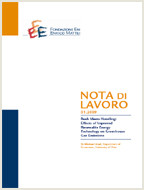The U.S. Proposed Carbon Tariffs, WTO Scrutiny and China’s Responses

06.03.2010
ZhongXiang Zhang
F18, Q48, Q54, Q56, Q58
Post-2012 Climate Negotiations, Border Carbon Adjustments, Carbon Tariffs, Emissions Allowance Requirements, Cap-And-Trade Regime, Lieberman-Warner Bill, Waxman-Markey Bill, World Trade Organization, Kyoto Protocol, China, United States
Climate Change and Sustainable Development
Carlo Carraro
With countries from around the world set to meet in Copenhagen to try to hammer out a post-2012 climate change agreement, no one would disagree that a U.S. commitment to cut greenhouse gas emissions is essential to such a global pact. However, despite U.S. president Obama’s recent announcement to push for a commitment to cut U.S. greenhouse gas emissions by 17% by 2020, in reality it is questionable whether U.S. Congress will agree to specific emissions cuts, although they are not ambitious at all from the perspectives of both the EU and developing countries, without the imposition of carbon tariffs on Chinese products to the U.S. market, even given China’s own recent announcement to voluntarily seek to reduce its carbon intensity by 40-45% over the same period. This dilemma is partly attributed to flaws in current international climate negotiations, which have been focused on commitments on the two targeted dates of 2020 and 2050. However, if the international climate change negotiations continue on their current course without extending the commitment period to 2030, which would really open the possibility for the U.S. and China to make the commitments that each wants from the other, the inclusion of border carbon adjustment measures seems essential to secure passage of any U.S. legislation capping its own greenhouse gas emissions. Moreover, the joint WTO-UNEP report indicates that border carbon adjustment measures might be allowed under the existing WTO rules, depending on their specific design features and the specific conditions for implementing them. Against this background, this paper argues that, on the U.S. side, there is a need to minimize the potential conflicts with WTO provisions in designing such border carbon adjustment measures. The U.S. also needs to explore, with its trading partners, cooperative sectoral approaches to advancing low-carbon technologies and/or concerted mitigation efforts in a given sector at the international level. Moreover, to increase the prospects for a successful WTO defence of the Waxman-Markey type of border adjustment provision, there should be: 1) a period of good faith efforts to reach agreements among the countries concerned before imposing such trade measures; 2) consideration of alternatives to trade provisions that could reasonably be expected to fulfill the same function but are not inconsistent or less inconsistent with the relevant WTO provisions; and 3) trade provisions that should allow importers to submit equivalent emission reduction units that are recognized by international treaties to cover the carbon contents of imported products. Meanwhile, being targeted by such border carbon adjustment measures, China needs to, at the right time, indicate a serious commitment to address climate change issues to challenge the legitimacy of the U.S. imposing carbon tariffs by signaling well ahead that it will take on binding absolute emission caps around the year 2030, and needs the three transitional periods of increasing climate obligations before taking on absolute emissions caps. This paper argues that there is a clear need within a climate regime to define comparable efforts towards climate mitigation and adaptation to discipline the use of unilateral trade measures at the international level. As exemplified by export tariffs that China applied on its own during 2006-08, the paper shows that defining the comparability of climate efforts can be to China’s advantage. Furthermore, given the fact that, in volume terms, energy-intensive manufacturing in China values 7 to 8 times that of India, and thus carbon tariffs have a greater impact on China than on India, the paper questions whether China should hold the same stance on this issue as India as it does now, although the two largest developing countries should continue to take a common position on other key issues in international climate change negotiations.
